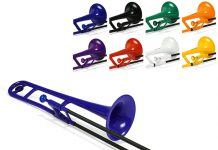The flutophone is an easy-to-play wind instrument that has existed since the early 1940s. In this article, you’ll learn more about this woodwind instrument, its difference from the clarinet and recorder, and why it’s recommended for young children and beginners. We’ve also included a step-by-step guide to jumpstart your flutophone mastery.
What is a Flutophone?

Flutophone looks like a toy flute, but it is a popular wind instrument commonly used in kids’ music education programs. It resembles a recorder but has a mouthpiece that looks like a whistle.
Josephus Brown Thompson invented this instrument in the 1940s following his dissatisfaction with the then-popular pre-band instruments like the saxette and tonette. Thompson collaborated with Maurice Eidemiller to design its holes before approaching a plastic molding company in Elyria, Ohio, for production.
The instrument’s popularity encouraged Thompson to invent other plastic instruments, such as the Skylark Kazoo Whistle, the Hezzle, the Dixie, and Piper Fifes.
What Are the Parts of the Flutophone?
The parts of the flutophone include the following:
- Mouthpiece: It is the part you blow into.
- Tone Holes or Finger Holes: You cover or uncover these holes to control the sound’s pitch.
- Thumb Rest: It helps you support the instrument while playing.
- Thumb Hole: Found at the back of the flutophone, above the thumb rest.
- Bell: It is the instrument’s flared end, which projects the produced sound.
Are Recorders and Flutophones the Same?
Although the two belong to the wind instruments family, they are not the same. Here are their differences:
Breath Control
A recorder requires considerable breath control to produce a stable and clear sound, which can be challenging for novices. On the other hand, the flutophone’s simple design and construction make it a more viable option for beginners who has yet to master the proper method of breathing on a wind instrument.
Tone
The whistle-like mouthpiece of the flutophone results in a less refined tone, which can be harsh to some listeners. On the other hand, a recorder has a soft tone that suits concert or band performances. This difference in tone quality can impact the choice of music and the musical style that fits each instrument best.
Finger Holes
The finger holes on a flutophone have grooves or raised finger holes, making it easier to confirm if you are covering the right hole. In contrast, the finger holes on a recorder are smooth.
Note Range
The flutophone and the recorder have the same note range of two octaves. However, they differ in starting and ending notes. Flutophone is from C4 to C6, whereas a recorder ranges from C5 to C7.
Keep in mind that the recorder has different types in varying note ranges, while a flutophone is available in one size.
Price
Recorders are pricier than flutophones. On average, flutophones cost between $2 and $5. Although a few models with a better sound or build quality cost around $10, they are still significantly cheaper than a recorder.
Physical Features
These wind instruments are similar in appearance, but there are some notable physical differences between them:
- Shape: Recorders usually have a straight, cylindrical shape, with a mouthpiece at one end and finger holes along the length of the instrument. On the other hand, flutophones have a tapered shape, with a broader bell at one end and a narrower mouthpiece at the other.
- Finger holes: As mentioned earlier, flutophones have raised finger holes with grooves, making it easier to know if you are covering the holes properly. Recorder holes, on the other hand, are smooth.
- Material: Most flutopphones are made from plastic, while recorders, depending on the price and quality, can be made either made from wood or plastic.
How to Play the Flutophone?
Whether you’re an amateur or have some experience with other musical instruments, the flutophone is easy to learn and can be a lot of fun to play. In this step-by-step guide, you will learn the basics of playing the flutophone, from how to hold the instrument to playing your first songs.
- You should start by holding the instrument correctly. Use your left-hand thumb to hold the back. The same hand’s index, middle, and ring fingers should cover the three upper holes. Then, take your right hand and place it on the bell. The right thumb should rest on the underside. Use the right hand’s index, middle, ring, and little finger to cover the lower four holes.
- Cover the right holes with your fingers and blow gently into the mouthpiece to produce sound. You can change your breath to adjust the instrument’s softness, loudness, and notes’ emphasis.
- If you want to play B, put your left hand’s index finger on the first hole and your thumb on the thumb hole at the back. To switch to A, cover the second hole. From A to G, cover all three holes and keep your thumb on the hole.
Final Thoughts
In summary, the flutophone is the perfect instrument to introduce kids and beginners to woodwind instruments and music in general because it is small, easy to play, and affordable.
Table of Contents






